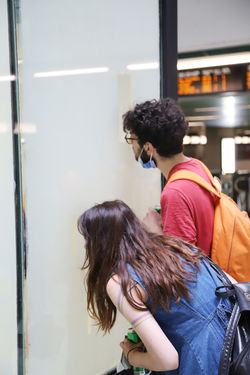 |  |  |  |
|---|---|---|---|
 |  |  |  |
 |  |
Flavia Tritto and Katarina Nesic
Curated by spazioSERRA
Critical text by Francesco Ferranti
On display from 15/06/2021 to 17/06/2021, between 08:00 and 18.30 (variable duration)
Opening Tuesday 15/06/2021 at 18:30
Lancetti railway station, Milan
Flavia Tritto (Bari, Italy, 1994) and Katarina Nesic (Vancouver, Canada, 1996) met at the Banff Center for Arts and Creativity where they were respectively attending a dance composition residency and a visual arts residency, and started collaborating right away. Flavia (1994; she/her) is an Italian multidisciplinary artist. Following her education in the social sciences, she obtained her MA Fine Art at Central Saint Martins in 2019. Since then, she has taken part in several international exhibitions and residencies. Katarina (1998; she/her) was raised in Vancouver, Canada on the unceded territories of the Sḵwx̱wú7mesh (Squamish), Səl̓ílwətaʔ (Tsleil-Waututh) and xʷməθkʷəy̓əm (Musqueam) peoples. She received her contemporary dance training at Arts Umbrella. Alongside her dance practice, Katarina is currently studying Literary and Cultural Analysis at the University of Amsterdam.
Francesco Ferranti (Barga, Italy, 1989) lives and works in Milan. Independent curator and art writer, he studied Classical Philology at Pisa University and Curatorial Practice at Bath Spa University. He has lived for 6 years between Bristol and London, where he curated events and collaborated with artists such as Prem Sahib, Atabey Mamasita, Rob Hesp. His curatorial practice, informed by queer theory and deconstructivism, is focused on concepts such as site-specific, agency, identity and representation. He curated the digital exhibition @spe_ctroom, which highlights queer emerging artists.
at a proximateDISTANCE
at a proximateDISTANCE, by visual artist Flavia Tritto and contemporary dancer Katarina Nesic, is the first performance proposed within venerazioneMUTANTE, the current exhibition season by spazioSERRA dedicated to the transformation of site-specific works during their permanence. The performance is divided into three phases, visible respectively on 15, 16 and 17 June at Lancetti railway station, in Milan.
“The intention of at a proximateDISTANCE” writes Francesco Ferranti in the critical text “is to create a relationship between the bodies and actions of the artists and the people who will transit around spazioSERRA, a non-place that is configured as a panopticon from which one sees and is seen, from which to control and be controlled”.
Act 1 Dwell out of sight
The windows, frames that direct the gaze towards the interior of the space, are veiled: thus they change their function and become similar to walls. At the same time their presence is revealed: they are not invisible mechanisms, but rather indispensable to the functionality of the space.
Nesic improvises in and around spazioSERRA, overcoming the binary distinction between inside to see and outside from which to observe. While Nesic's performative gestures dissolve in their succession, Tritto marks the passage of time of the performance, like a clock. Starting from the assumption that different descriptions create different realities, the dancer intends to open the space to multiple alternatives of perception: queering the space.
Act 2 In between there’s always surface
Nesic moves inside spazioSERRA, but her body is only visible through the actions that Tritto performs on the structure of space. More effort is required from the viewers: they have to get closer to the space to see inside.
Act 3 Now we dance
spazioSERRA's structure is revealed again, one piece at a time, until it returns to its original state. The structure is what remains at the end of the performance, the trace of the process remains in the idea of those who attended.
Through individual action, which is expressed in the performance, the personal perception of the material and social structures changes. Francesco Ferranti writes “Starting from the idea that ‘by describing a world, you are creating it’ (Stevens 1996), the performers will be responding differently to the space, providing different accounts while taking the risk of vulnerability and being watched for long hours over the three days of the performance”. The way we behave in a space changes according to our desire to be visible or invisible. This contrasts with real exposure, which does not depend on our control, and makes us vulnerable.
